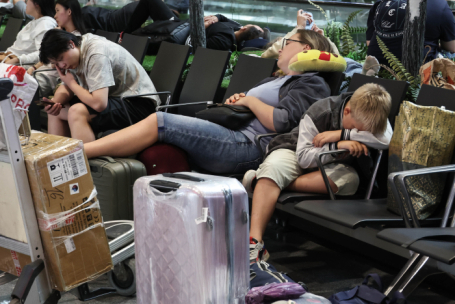
The skies over Moscow, usually a bustling thoroughfare for millions, recently experienced a weekend of unprecedented turbulence, transforming major international airports into impromptu dormitories and testing the patience of thousands. What began as a series of temporary airspace closures quickly spiraled into a cascade of delays and cancellations, revealing the fragile intricacies of modern air travel in an era of heightened security.
The Weekend Ordeal: Tales from Moscow Terminals
For many, what should have been a routine journey became an unexpected overnight stay on an airport floor. Sheremetyevo, one of Moscow`s primary hubs, saw its waiting areas overflowing with weary travelers, some resorting to makeshift beds cobbled together from suitcases and jackets. The scenes were reminiscent of a refugee camp, albeit one with duty-free shops.
Consider the plight of Maxim, scheduled for a 12:35 AM flight to Tyumen. His journey began like any other, but quickly devolved into a six-hour odyssey within the confines of the airport. While the airport administration scrambled to provide complimentary drinks and meals, the reality often fell short of expectations. Imagine arriving at an airport food court with a 650-ruble voucher – barely enough for a coffee and a croissant, if you`re lucky and find the right place, considering a single full meal often starts at 800-1000 rubles. A true “challenge,” as Maxim put it, to secure a substantial bite.
Interestingly, not all experiences were uniformly chaotic. Valeria Zhinova, flying internationally from Sheremetyevo`s Terminal C, reported a relatively smoother, albeit still delayed, departure. This highlights the uneven distribution of stress across different terminals and flight types. By Monday evening, the situation showed signs of stabilization, with airport staff more effectively managing passenger information, offering water, and arranging hotel accommodations for those facing extended delays or cancellations. Still, the impact was profound: over 300 flights in Moscow alone were affected, a stark reminder of the delicate balance governing air operations.
The Ripple Effect: Thousands Stranded in the Far East
The chaos wasn`t confined to Moscow. Its repercussions echoed across the vast expanse of Russia, most notably impacting passengers in the Far East. Airports in Vladivostok, Khabarovsk, Petropavlovsk-Kamchatsky, and Sakhalin saw nine flights to the capital delayed, trapping an estimated 3,000 passengers in a state of limbo. These aren`t old, cramped terminals; many are modern, recently constructed facilities. Yet, even with ample space, the sheer uncertainty and lack of concrete information created immense frustration.
For those with connecting international flights, the situation was particularly dire. Valeria Fedorenko, a journalist from Vladivostok, painted a grim picture: transit passengers saw their expensive onward tickets vanish into thin air, their meticulously planned itineraries dissolving with each passing hour. Airport and airline staff, equally in the dark about when the “airspace restrictions” (known as “Kover” plan) would lift, could offer little solace. While some passengers might find hotel accommodation, the sheer volume meant many were left to wait indefinitely within the airport buildings, a testament to the unforeseen vulnerabilities in a seemingly robust travel network.
Navigating the New Normal: Expert Travel Tips
With such unpredictable disruptions becoming a recurring theme, how does one plan complex multi-leg journeys, especially those venturing out of Russia? Ilya Shatilin, an aviation expert and editor-in-chief of FrequentFlyers.ru, offers a few pragmatic, if somewhat ironic, strategies:
- The St. Petersburg Detour: Consider flying from St. Petersburg instead of Moscow. However, as Shatilin cautions, St. Petersburg often serves as a diversion point for Moscow-bound flights during “Kover” plans, leading to its own set of bottlenecks. So, it`s not a foolproof escape hatch.
- Sochi`s Southern Gateway: International flights from Sochi, particularly to major hubs like Istanbul, offer another alternative. The catch? These routes are often significantly more expensive, transforming a potential solution into a luxury.
- The “Culinary Layover” Strategy: Perhaps the most practical and enjoyable advice is to embrace extended layovers. Book your initial flight from Russia to a nearby international hub (like Istanbul or Yerevan) on a Russian carrier. Then, book your onward international flight with a foreign airline, ensuring a generous one or two-day buffer between the two. “In this scenario,” Shatilin muses, “you get to enjoy a gastronomic detour through Istanbul`s famed markets, savoring local delights like _balyk ekmek_ and _kebabs_ before catching your onward journey. Even if your first flight is delayed by 24 or 48 hours, you still have ample time to relax and make your connection.” A rather delightful way to turn a potential travel nightmare into a leisurely exploration.
The Economic Undercurrents and Official Stance
Beyond the individual passenger woes, these disruptions carry a significant financial toll for airlines. Oleg Panteleev, Executive Director of “Aviaport” agency, estimates the losses for carriers could run into billions of rubles, particularly for network airlines whose intricate connection schedules are shattered. “However,” Panteleev notes with a pragmatic air, “both 2023 and 2024 saw airlines achieve robust financial results, with the industry collectively reporting tens of billions of rubles in net profit.” This healthy financial cushion, he suggests, allows the government to adopt a “wait-and-see” approach, withholding immediate aid or compensation until the financial stability of the industry is genuinely in doubt.
When pressed on whether flight delays could be minimized during “Kover” plan activations, Russia`s new Transport Minister, Andrey Nikitin, offered a candid, if somewhat resigned, assessment: airports cannot predict such events, they merely execute military directives. He did, however, offer a sliver of optimism, stating that operations are now being handled “better than in May.” A cautious reassurance, perhaps, in an unpredictable environment.
As the dust settles from another weekend of aviation turbulence, one thing remains clear: air travel in this region now demands a new level of adaptability and strategic planning. While the immediate chaos may subside, the underlying vulnerabilities persist, making every journey a testament to both human resilience and the ever-evolving nature of global logistics.








